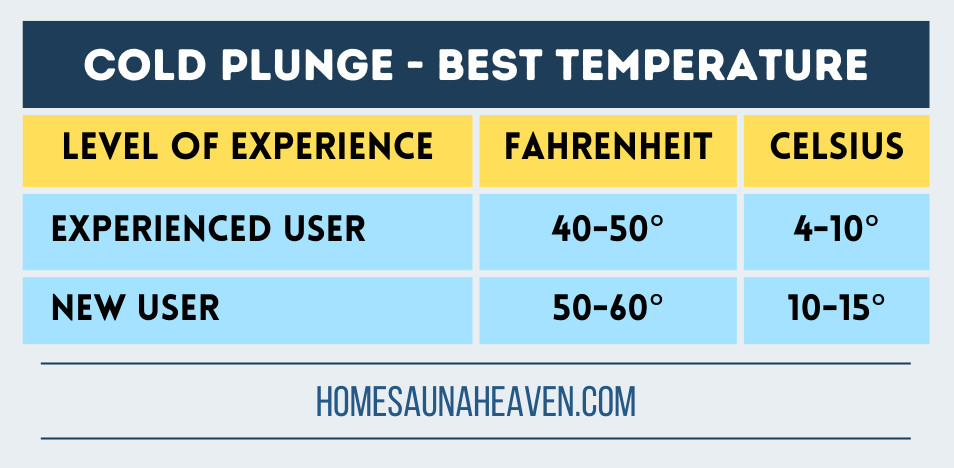
Yes, cold plunge is safe – as long as you follow some basic safety advice and know what you’re doing. There are some risks involved and several safety tips you should follow to keep yourself safe and have a positive experience. Key to these are considering your individual health, seeking professional medical advice, choosing a suitable immersion duration and water temperature, gradual progression, and always plunging with a partner.
Cold Plunge Safety Tips – 8 Tips for Staying Safe While Cold Water Plunging
Want to get the most from your cold plunge and stay safe? Follow our cold water safety tips below. You’ll soon be feeling the full effects of a cold water plunge and its potential benefits without encountering the most common problems associated with cold water immersion.

1: Your Individual Health
The most crucial piece of safety advice for cold water plunging is to consider your individual health. Do you have any underlying conditions that affect your ability to safely immerse in cold water? Cold water dipping is not for everyone and you should consider any potential health risks before you take the plunge.

If you suffer from a heart problem, circulatory issue, diabetes, hypertension, a respiratory condition, or Raynaud’s disease you may not be suitable for cold plunging. You should also consider your overall physical fitness. If you’re in poor physical condition you may be more susceptible to the potential risks associated with cold water plunging.
2: Seek Professional Medical Advice
Another top cold plunge safety tip is to seek professional medical advice before you begin. If you have any underlying health conditions, or any doubts at all, you should seek the opinion of a healthcare professional before submerging in cold water. A doctor can advise if cold water immersion is safe for you based on your medical history and current health status. The best advice is to practice caution.

Cold water immersion can be dangerous for some people. They may recommend specific precautions, such as limiting the duration and water temperature during cold water exposure. This way you can enjoy the potential benefits of cold plunging while staying safe. Always prioritize your health and well-being when considering any form of cold water immersion therapy.
3: Duration of Plunge
The duration you stay immersed in cold water is another critical safety factor of cold plunging. In general, individuals new to plunging should start low. Very brief periods work best. And, as your body gets accustomed to the practice, you can begin gradually increasing the period of immersions – if you feel comfortable doing so. More experienced users can aim for a longer duration. In general, the following times can be used as a guideline

Prolonged exposure to cold water can lead to hypothermia. This is a dangerous condition where your body loses heat faster than it can produce it. Symptoms of hypothermia include uncontrollable shivering, confusion, and numbness.
It can be life-threatening if not treated promptly. If you begin to shiver or feel lightheaded in a cold water bath, you should exit the water immediately and seek warmth. For more, see our full guide on How Long Should I Stay in a Cold Plunge?
READ NEXT
• Best Cold Plunge Review – click here
4: Water Temperature
You should pay close attention to the temperature of the water. Choosing a water temperature that is overly cold can impact your comfort and safety. Extremely cold water, such as near-freezing temperatures, can be dangerous and lead to cold shock and hypothermia.

In general, the best water temperature for cold plunging is between 40-60 degrees Fahrenheit. It’s cold, but not too cold. However, personal tolerance to cold water varies from one individual to the next. Listen to your body and avoid water that feels too cold or uncomfortable.
Experienced users tend to plunge in water with a temperature between 40-50 degrees Fahrenheit. While new users do better with a water temperature of between 50-60 degrees Fahrenheit. As you become accustomed to cold water and your body adjusts to the process, you can gradually decrease the water temperature. Check out our full guide on Cold Plunge Water Temperature.
5: Gradual Progression
Gradual progression is key. Don’t jump in at the deep end. Start low and slow. Then, gradually work your way up if your body is responding positively. This means, starting with a reasonable temperature and duration that doesn’t push you too far out of your comfort zone.

Give your body time to adjust to the process. Then, if you feel comfortable, you can gradually reduce the water temperature and increase the duration. It’s all about baby steps. This approach helps your body build tolerance to the cold. The last thing you want to do is experience cold shock or suffer hypothermia. For more see – How Often Should You Cold Plunge?
6: Always Plunge with a Partner
Is cold plunge safe? It’s safer if you plunge with a partner. Don’t cold plunge alone. Especially if you are new to the activity of immersing in a new cold water location. Taking someone along means you have help if something goes wrong. If you get into difficulty your partner can help or raise the alarm.

Cold water immersion can lead to some unexpected reactions. These include cold shock and hypothermia. These adverse reactions can impair your ability to think and act rationally. Having a partner with you ensures there is someone there to monitor your plunge and ensure everything runs smoothly. They can help you exit the water if something goes wrong and call for help or provide first aid if necessary.
7: Listen to Your Body
Everyone has a different tolerance for cold water. We all react differently when we first take the plunge. One of the best cold water immersion safety tips is to listen to your body. How does your body react when you are immersed in cold water? Pay attention to the signals and make adjustments as necessary.

For example, if you experience a high level of discomfort, shivering, or numbness, exit the cold water immediately. The temperature is too cold for your body. And, you need to get out and warm up right away. Cold water can affect us all differently, so listen to your body and personalize your cold plunge experience for best results.
8: Warm-Up Afterwards
Once you’re done, you need to focus on warming up. Cold water immersion can lower your core body temperature significantly. This needs to be raised back to a comfortable range. Make sure you have a towel ready to dry off when you’re done. A brief visit to a sauna works wonders for warming back up – either infrared sauna or traditional sauna.

And, that you have warm clothes for getting dressed as soon as you get out. This will prevent further heat loss and ensure your body retains the warmth needed for safe recovery and comfort. The last thing you want to happen is to get cold and struggle to warm back up after an ice bath.
Can You Cold Plunge while Pregnant?
Is it safe to cold plunge when you are pregnant? Cold plunging while pregnant is not recommended. Prenatal safety is of utmost importance. And, exposing your body to very cold water during pregnancy can pose several risks to both mother and baby. Professional medical advice should sought for further advice. Below are some of the potential risks of cold plunging when pregnant.

• Hypothermia
Pregnancy affects your body’s ability to regulate temperature. This makes you more susceptible to hypothermia when immersed in cold water.
• Decreased Blood Flow
Cold water immersion constricts blood vessels. This reduces blood flow to your extremities and can lead to a decrease in oxygen and nutrients reaching the fetus.
• Risk of Falling
The physical changes that occur during pregnancy, such as a shift in center of gravity, increase the risk of trips and falls. And, immersing in cold water involves navigating wet slippy surfaces. Put the two together and you have an increased risk of falling.
• Increased Cardiovascular Activity
Cold water plunging can lead to a significant increase in heart rate and blood pressure. If you’re pregnant this can cause increased stress on the cardiovascular system.
For more, check out Is Cold Plunge Good For You?
READ NEXT
About the Author
MAGNUS KARLSSON (BSc, MSc)
• Senior Editor at Home Sauna Heaven
As a native Swede, Magnus developed a deep fascination with the art of sauna bathing from a very early age. Born and raised in the picturesque landscapes of Småland Sweden, he grew up in a family where sauna was deeply embedded in the community and daily routine. He graduated from Linnaeus University with a Master of Science in Health Science with a special focus on the “Comparative Analysis of Traditional Saunas vs. Infrared Saunas”.
Moving to the United States in his late twenties, Magnus worked as a health and fitness advisor in a well-known spa and wellness retreat in Malibu California. Over the next 12 years he became the spa’s leading sauna consultant and mentored colleagues on the benefits and applications of sauna therapy.
In 2019 he relocated to Florida to open his own wellness retreat in the Tampa Bay area. Here he continues to inspire others with the restorative power of sauna therapy. In 2020, he became senior editor of Home Sauna Heaven where he shares his deep understanding of infrared sauna and offers expert advice on its applications, benefits, and periodic product reviews.
